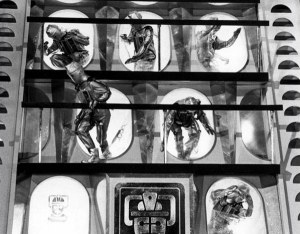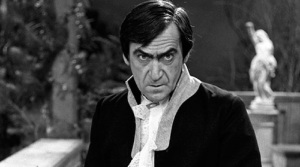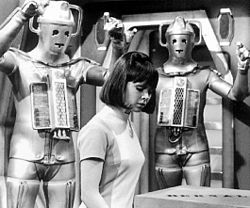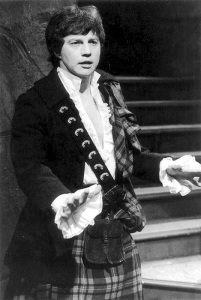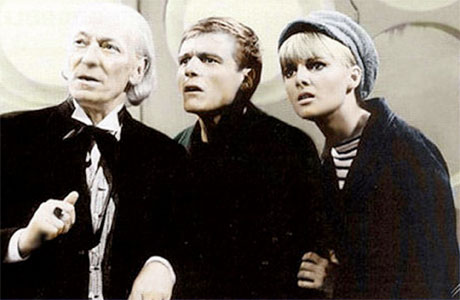
For a show that purports to be about “all of space and time”, Doctor Who spends a hugely disproportionate amount of time on Earth (a phenomenon which will dominate the seasons ahead of us under the Third Doctor). That’s not the case, though, in Season Six; we see more alien worlds than in any previous season. Let’s get started!

The Dominators, seen here at the height of 1960s fashion.
The season opens with The Dominators, an alien invasion story with a twist: the world getting invaded is not Earth. Rather, it’s the planet Dulkis. For the first time since I started tracking the dates of the serials, I was unable to find any; this story has the unusual combination of being set on another world and being a mostly self-contained story, and nothing inside the evidence indicates the date. I’m guessing from the technology that it’s the relatively near future, but I have no evidence to back up that claim. There’s an interesting moment in episode two, where the Dominators examine Jamie and conclude that he is vulnerable because he has only one heart. They don’t examine the Doctor, assuming he is the same. Later, the Dulcians are revealed to have two hearts. I can’t help wondering if this scene inspired the later revelation that the Time Lords also have two hearts. The Sonic Screwdriver makes a second appearance here, and in dramatic fashion, burning through the wall like a large torch (but remember, it’s a scientific instrument, not a water gun!). The Dominators struck me as particularly calloused villains. They really have no interest in the planet or its people, and enslaving them is an afterthought; they only want to blow up the planet for fuel. We don’t often see that degree of callousness in the series. This is also our first good look at Zoe as a member of the crew; she’s disconcertingly childlike in appearance, and seeing her spout advanced technical knowledge is jarring. I like her as a character though.

Jamie and Zoe vs. the White Robots
I had seen serial two, The Mind Robber, before, but with no context. It doesn’t occur on Earth, but rather, in the mysterious Land of Fiction, which may or may not be a planet at all. I remember being confused at first by the references to “the Master”, as the Time Lord by that name doesn’t appear until the Third Doctor’s era; of course they are referring to the master of the land of fiction instead. This serial shares similar themes, in my opinion, with The Celestial Toymaker and the much later Amy’s Choice. Like the preceding serial, I could find no projected dates; the only clue we have is that it includes a circa-2000s comic book character, the Karkus, but that is little help in placing the story. The Minotaur seen here becomes something of a motif, with variations showing up later under the third, fourth, and eleventh Doctors. As well, there’s a “Captain Jack Harkaway” in the stories written by the Master; maybe a partial inspiration for Captain Jack Harkness? I had to laugh at one point; the Doctor gets thrown around in a fight with the Karkus, who then gets manhandled by tiny little Zoe. No Venusian Aikido yet!
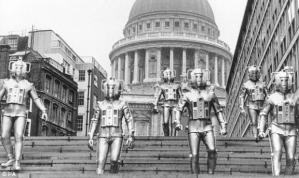
Cybermen in London. Why does no one ever remember these invasions?!
The Invasion is a partial reconstruction, which is increasingly rare this season, and will soon end altogether. The quality of the version I saw was particularly bad, but fortunately it had subtitles. It’s a Cybermen story, with a new appearance that will remain unchanged for a few years. We don’t know much about these Cybermen; they are presumably descendants of the Mondasian Cybermen, but they claim to originate from “Planet 14”, presumably the fourteenth planet of the Solar System (Mondas was tenth). I suspect the original intent was that Planet 14 be synonymous with Telos, but internal chronology and later media contradict this. The Doctor has met them on that planet at some point, but this is never seen, and must have happened off camera. The Cybermen meet UNIT in this episode—the agency’s proper introduction in the series—and Alistair Lethbridge-Stewart returns, this time with his familiar rank of Brigadier. (“It’s Brigadier now, I’ve gone up in the world.”) The best date I could locate is summer of 1979 (incidentally, the year I was born), which seems fairly consistent with the technology in view. The Cybermen have a Cybercontroller here, but it is a stationary unit, not a mobile Cyberman. Zoe knows ALGOL, which must have been a positively ancient computer language by her time. The TARDIS is seen to be able to turn invisible; I would have thought that was a function of the broken chameleon circuit, but apparently not. The suspense in the story is excellent; the Cybermen don’t appear onscreen until the end of episode four (of eight). Notably, this was Terrance Dicks’ first credit on the show.

The Krotons
Yet another undateable story appears with The Krotons. It occurs on the unnamed planet of the Gonds, and seems to be in the future, but without any verifying context. I like the crystalline Krotons, and would like to see them get a new and updated appearance in NuWho. They look primitive here, in keeping with the production values of the time, but that could be explained away by the primitive circumstances under which they revive themselves on the Gond planet; it could be said that at the height of their power, they look and sound different. The story exemplifies something I love about Doctor Who: stories that aren’t just black and white, good and evil, but rather, involve conflict among various factions with conflicting interests. Here you have the Doctor and his companions, several factions among the Gonds (who agree on the threat of the Krotons, but not on what to do about it) and the Krotons themselves. They aren’t all good or evil; they just disagree. It’s so much more believable this way. The ending reminds me of the scenes in Rose with the Nestene Consciousness. Also, the concept of the HADS (Hostile Action Displacement System) in the TARDIS is introduced, and is later used by the Eleventh Doctor. Such a simple and elegant solution to attacks.
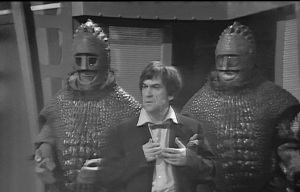
“Them? Oh, they’re with me.”
We return to Earth for The Seeds of Death (not to be confused with the later The Seeds of Doom). We can’t be precise about the date, but there is enough evidence to place it in the mid-21st Century, before the year 2050. A History of the Universe places it somewhat arbitrarily in 2044, and I find that to be a fair guess. It introduces the concept of T Mat (“Travel Mat”, later transmat) teleportation, which is more common in NuWho, especially as used by the Daleks. It’s been in existence for a few years on Earth, just long enough to be both common and regulated. This is the second appearance of the Ice Warriors of Mars and their sonic weapons…sure would be nice if the Doctor had a sonic—wait, sorry, I can’t make that joke anymore. Anyway. This story occurs before The Ice Warriors, therefore they are not familiar with the Doctor. However, it appears that these Ice Warriors are contemporary, whereas the previous group were ancient, having been frozen in the ice for millennia. There’s a space museum (another minor recurring theme by now?) on the moon, and a staff member named Osgood, whom I would like to think is a relative of the Osgood of NuWho. It’s not made clear whether the moon base here is the same as the one from the serial of that name. In a rare moment of deviation from character, the Doctor directly kills one Ice Warrior and is responsible for the death of at least one more. The moon landing seen in episode three is a bit farfetched, but then, the serial was broadcast some months before the real moon landing.

A face not even a mother could love
I had difficulty getting into The Space Pirates, which is a pity, because it was actually a great story; I just felt it was poorly done. Date is hard to establish, but it appears to be in the very early days of Earth’s colonization of space (an onscreen reference indicates 1992, but that is contradicted by dialog indicating at least fifty years of deep space travel). A History places it in 2119, 150 years after the broadcast date. This is the final reconstruction! All further serials are available in their entirety. It goes out with a bang, though; only episode two (of six) is complete. To me, this is a clear early example of the TARDIS taking the Doctor where he needs to go rather than where he wants to go; after all, it’s pretty unlikely that the TARDIS would randomly materialize on a tiny, unmanned beacon in space.

A Time Lord’s last adventure
We end with The War Games. This is it: The final serial of the Second Doctor’s era. It’s difficult but not impossible to date; it appears at first to date to WWI, but of course that is an illusion. A History says this, which I think is best quoted rather than paraphrased: “It is stated that humanity has been killing itself for ‘half a million years’ before this story takes place, which (coincidentally) ties up with the date 309,906 established for the [Fourth] Doctor’s first Trial (or “Malfeasance Tribunal”) in The Deadly Assassin [which, in my opinion, looks to be a VERY good serial indeed!]. There are a lot of firsts and lasts here: First appearance of the Time Lords en masse and under that name; first appearance of Time Lord hypercubes (telepathic communication cubes, as later seen in The Doctor’s Wife); first appearance of the SIDRAT time travel machines, which are much like scaled-down TARDISES; first appearance of Gallifrey, though not with that name. It’s also the last appearance of Jamie and Zoe (with the exception of reunion episodes); last adventure of the Second Doctor; and last black and white episode.

Our first view of Gallifrey–the TARDIS docking bay. Note the open TARDISes on the right wall.
This serial is weighty in the canon of Doctor Who, and it’s hard to do it justice. A few observations presented themselves, though. The SIDRATs provide an explanation for the long-perplexing problem of why the Doctor can’t control the TARDIS remotely: any time ship that has a malleable interior (as the TARDIS does) and remote control capabilities will be inherently unstable. No explanation is given as to why that should be, but there you have it. Also, the Time Lords seem to be able to (mostly!) recognize each other on site in spite of regenerations; the Doctor had not been to Gallifrey since his first body, but he is instantly recognized by the War Chief. We see some uncamouflaged TARDISes in the docking bay on Gallifrey, and it’s worth noting that they are rectangular rather than spherical as seen in The Name of the Doctor; probably a later model, as the Doctor’s TARDIS was found in a maintenance bay and outdated. I didn’t realize that it was established this early that Time Lords can control the appearance of their regenerating bodies; it seems odd that it’s such a crapshoot for the Doctor later on, but then, that probably is because of the absence of the Time Lords.

The Second Doctor, Patrick Troughton (RIP)
I find the Second Doctor’s tenure to be fascinating, because by definition it must be the shortest era of any Doctor with the possible exception of Nine. Jamie is with the Doctor consistently throughout his entire era, start to finish, and ages only a very little. Therefore even if there are a few unseen adventures, there cannot be vast swaths of time unaccounted for. And yet, so much foundational material was delivered in that short time! All in all, I’ve enjoyed the second Doctor’s run much more than the first (who wasn’t bad himself).

Regeneration
Next time: The Third Doctor arrives on Earth! These entries should become shorter, as well, as the upcoming seasons contain fewer stories. See you there!
All episodes can be viewed on Dailymotion; links are below. Due to the BBC’s early policy of junking tapes, some episodes exist only as reconstructions.




